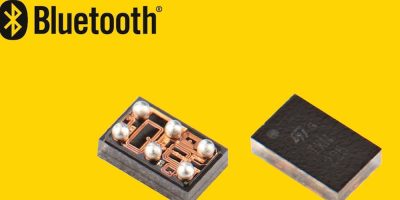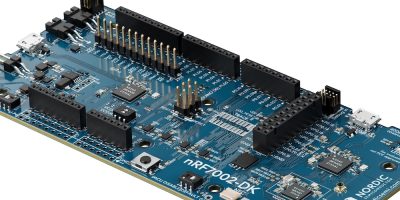STMicroelectronics has extended its range of single-chip antenna-matching ICs that simplify RF-circuit design with two new devices optimised for BlueNRG-LPS system-on-chip ICs (SoCs) and STM32WB1x and STM32WB5x wireless microcontrollers.
The MLPF-NRG-01D3 for BlueNRG-LPS and MLPF-WB-02D3 for STM32WB integrate the complete filtering and impedance-matching network needed for best RF output power and receiver sensitivity with an external antenna. Each has 50Ohm nominal impedance on the antenna side. The chip-scale package has a minuscule footprint, 0.4mm bump pitch and a profile of only 630micro after reflow soldering. Also featuring a 2.4GHz low-pass filter, ST’s antenna-matching ICs ease compliance with worldwide radio regulations, including FCC, ETSI, and ARIB specifications.
The circuit elements are fabricated on a glass substrate leveraging ST’s integrated passive device (IPD) technology, which, the company claimed, minimises insertion losses and outperforms circuits built with discrete components. Integration on the same die is said to ensure consistent component parameters for end-product quality. In addition, ST’s IPDs help accelerate time to market, reduce bill-of-materials costs and miniaturise circuit dimensions.
The BlueNRG-LP and Blue NRG-LPS SoCs and STM32WB1x and STM32WB5x contain ST’s energy-efficient 2.4GHz radio IP and come with royalty-free protocol stacks and dedicated software tools. They help developers quickly design state-of-the-art wireless products, even without having extensive RF-design skills. Both provide on-chip features such as memory, peripherals, communication interfaces, power regulation and advanced hardware security including encryption, memory protection and public key acceleration (PKA).
BlueNRG-LPx SoCs can be used in standalone or network processor applications and support Bluetooth Low Energy 5.3 features including point-to-point and mesh communications, advertising extensions and direction finding.
The MLPF-NRG-01D3 IPD is compatible with all variants, comprising the BLUENRG-3x5Vx, BLUENRG-3x5Ax and BLUENRG-332xx in UFQFPN and WLCSP packages.
The STM32WB5x and STM32WB1x MCUs are Bluetooth 5.3, Zigbee 3.0 and OpenThread certified and feature an Arm Cortex-M4 core for application processing with a Cortex-M0+ dedicated to managing the radio. They are available in WLCSP and UFBGA packages that connect directly to the MLPF-WB-02D3 IPD. A different IPD is available for other MCU variants in UQFN and VQFN packages.
The MLPF-NRG-01D3 and MLPF-WB-02D3 single-chip antenna-matching ICs are available from $0.14 for orders of 1,000 pieces.







